Matador Network's Blog, page 39
May 29, 2025
Where To Eat, Play, and Stay in Dallas for the 2026 World Cup

Dallas is the only 2026 World Cup host city that will offer western flair mixed with world-class urban chops. The city’s entertainment hubs – Deep Ellum, downtown, and in Arlington near the stadium, the Arlington Entertainment District – will be the best places to stay in or near. The city itself will offer a vibrant and exciting place to visit, just be prepared for those hot summer nights (and even hotter days).
Visit the National Soccer Hall of Fame
Photo: Dorti/Shutterstock
The National Soccer Hall of Fame, located in Frisco, Texas at Toyota Stadium—home to FC Dallas—serves as the premier destination for honoring American soccer legends. Originally established in 1950 and reopened in 2018 after extensive renovations, the Hall of Fame features a 19,350-square-foot facility filled with cutting-edge interactive exhibits. Visitors can engage with displays using facial recognition technology to customize their journey, and explore immersive virtual reality experiences. Highlights include iconic memorabilia from stars like Pelé and Clint Dempsey, and all four of the U.S. Women’s National Team’s World Cup trophies. The Hall honors contributors in three categories—Player, Builder, and Veteran—with recent inductees such as Carli Lloyd, Chris Armas, Nick Rimando, Mary Harvey, and Mark Abbott.
Open Wednesday through Sunday, the Hall offers varied admission pricing and a special $5 entry on Wednesdays. Located about 30 minutes from both major Dallas airports, it provides convenient access and ample parking on site. Guests can also visit the Soccer 90 retail store without a ticket for a wide selection of soccer merchandise.
National Soccer Hall of Fame: 9200 World Cup Way, Frisco, TX 75033
What to do and eat in Deep Ellum during the 2026 World CupDeep Ellum is the place to be in Dallas if you enjoy vibrancy and culture. Its renowned for its energetic nightlife, live music venues, street art, and eclectic dining. It’s a hotspot for fans who want to celebrate before and after matches, offering everything from craft breweries to rooftop bars and late-night eateries. It’s also a creative hub and there’s always something going on – from watch parties to concerts to street festivals. Deep Ellum is just east of Downtown Dallas, 25-30 minutes by car to the stadium, though public transit is easy and cheap.
Off The CuffView this post on Instagram
A post shared by Off The Cuff (@offthecuffdallas)
A wall of TVs, a big beer menu, and a reputation as the place to watch sports in Deep Ellum make Off The Cuff a solid choice for match watching during the World Cup. Make a reservation in advance as this sports-bar-cum-night-club gets packed with a line around the block on weekends. Watch here, then walk down the street to catch some live music.
Off The Cuff: 2901 Elm S
Double Wide BarView this post on Instagram
A post shared by Modern Electric Sound Rec. (@modern_electric)
Double Wide Bar is an anomaly – it’s divey and casual, has a country-fied name, and yet is a place where you’ll find everyone from punks to hipsters to high-classers rounding out their evening in Deep Ellum. Grab a PBR and strike up a conversation – the person you’re speaking with could be traveling with one of the teams. The live music is consistently awesome here, too.
Double Wide Bar: 3510 Commerce St
Serious PizzaView this post on Instagram
A post shared by Serious Pizza (@seriouspizza)
For a late-night slice after a watch party (or a match at the stadium, if you’re headed this way after) head into Serious Pizza. The stuff is delicious – and cheap, plus its served until midnight.
Serious Pizza: 2807 Elm St
We hope you love the spaces and stays we recommend! Just so you know, Matador may collect a small commission from the links on this page if you decide to book a stay.
Epic house for 14 people with pool, rooftop patio Photo: Airbnb
Photo: Airbnb Photo: Airbnb
Photo: Airbnb Photo: Airbnb
Photo: Airbnb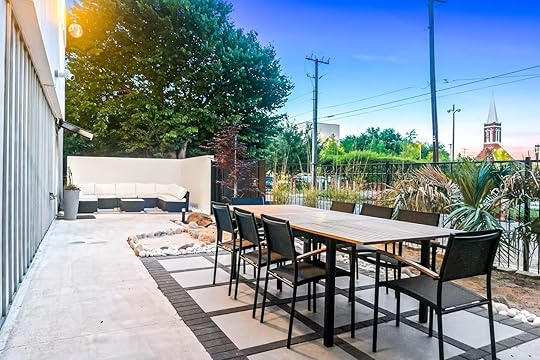 Photo: Airbnb
Photo: AirbnbRenting this home will make you feel like royalty – and you get to split the bill with up to 13 other people. The second bedroom has what must be the most incredible double-queen-bed bunk bed setup the world has ever seen, while the master bedroom opens up to a patio overlooking the skyline. Easy access, easy living.
Stylish Deep Ellum loft with a pool table, community pool Photo: Airbnb
Photo: Airbnb Photo: Airbnb
Photo: Airbnb Photo: Airbnb
Photo: Airbnb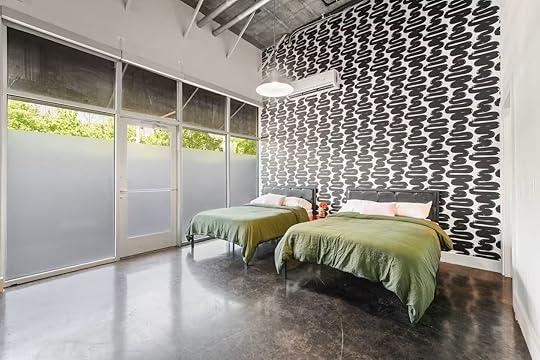 Photo: Airbnb
Photo: AirbnbWith the pool table, community pool and deck, and luxury amenities at this apartment complex, you’ll be hard pressed to actually make it out to the match. You can host your own match watching session here with your travel crew, and lounge on the stylish furniture. Sleep up to six and take advantage of the gym and other amenities as needed – plus the ease of access to the neighborhood.
What to do and eat in Arlington during the 2026 World CupThe Arlington Entertainment District is set to be one of the most electric places to watch and celebrate the World Cup in North Texas. With the tournament drawing fans from around the world, Arlington’s mix of stadium energy, lively sports bars, and accessible attractions makes it an ideal base for soccer enthusiasts. Just steps from AT&T Stadium and Globe Life Field, this neighborhood has everything you need for an unforgettable matchday experience—cold drinks, good food, and a passionate crowd.
Texas Live! – The ultimate World Cup watch party hubView this post on Instagram
A post shared by Texas Live! (@tx_live)
If you’re looking for a stadium-adjacent venue that delivers on both atmosphere and screen real estate, Texas Live! is the place to be. This massive entertainment complex features a dozen venues under one roof, including Live! Arena, where a 100-foot LED screen and stadium seating create a game-day environment like no other. During the World Cup, expect themed drink specials, fan gear giveaways, and crowds waving flags from around the globe. It’s loud, it’s festive, and you won’t miss a single minute of action.
Texas Live!: 1650 E Randol Mill Rd, Arlington, TX 76011
Cartel Taco BarView this post on Instagram
A post shared by Cartel Taco Bar (@carteltacobar)
For a more local and low-key scene, Cartel Taco Bar offers a curated menu of street tacos, craft cocktails, and regional beers in a stylish setting. With TVs positioned throughout the space and a rotating list of match screenings, it’s an excellent spot for fans who want strong flavors with their fútbol. The patio often fills up quickly during high-profile games, so arrive early and pair your match with house-favorite tacos like the chorizo-potato or birria.
Cartel Taco Bar: 506 E Division St #150, Arlington, TX 76011
Visit Arlington’s soccer parks and Fan Zones
Photo: Trong Nguyen /Shutterstock
Beyond bars and restaurants, Arlington is embracing its role as a soccer hotspot by hosting fan zones and community play spaces. The Arlington Soccer Association Complex will host mini pitches and pickup games. Levitt Pavilion and nearby parks host outdoor watch parties and family-friendly events.
Where to stay in Arlington during the 2026 World CupComfortable home close to Arlington Entertainment District Photo: Airbnb
Photo: Airbnb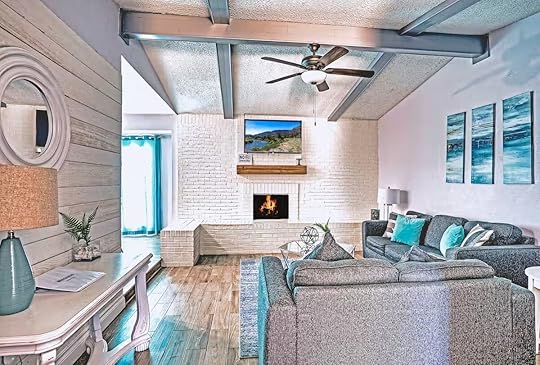 Photo: Airbnb
Photo: Airbnb Photo: Airbnb
Photo: Airbnb Photo: Airbnb
Photo: AirbnbStay in a nice suburban-style home in Arlington that’s a quick Uber ride from both the Arlington Entertainment District and the stadium. The home has three bedrooms with room for up to six, ideal for a crew or family.
Home 10-minute walk to AT&T Stadium Photo: Airbnb
Photo: Airbnb Photo: Airbnb
Photo: Airbnb Photo: Airbnb
Photo: AirbnbThis home is within walking distance to the stadium and a short Uber ride to Arlington Entertainment District. It’s a typical house, room for six across two bedrooms and a generous living space, and it’s not far from DFW airport, either.
What to eat and do in Downtown Dallas during the 2026 World CupDowntown Dallas is a prime location for World Cup fans looking to immerse themselves in the energy of the tournament while enjoying the city’s best food, nightlife, and cultural amenities. With easy access to DART transit and the World Cup Fan Fest at nearby venues, downtown offers a walkable core filled with rooftop bars, big-screen viewing parties, and international cuisine.
Frankie’s DowntownView this post on Instagram
A post shared by Frankie’s Downtown Dallas (@frankiesdowntown)
A mainstay of downtown’s sports bar scene, Frankie’s Downtown pulls out all the stops during major tournaments. With more than 40 HD TVs, a full menu of comfort food favorites, and local craft beers on tap, it’s the go-to for fans who want volume, atmosphere, and a front-row seat to every match. The bar hosts themed World Cup watch parties, and draws an international crowd—expect spontaneous chants, jersey swaps, and standing-room-only on big game days.
Frankie’s Downtown: 1303 Main St
Sky BlossomView this post on Instagram
A post shared by Sky Blossom Rooftop (@skyblossomrooftop)
For a more elevated experience, head to Sky Blossom, a Vietnamese fusion rooftop restaurant with panoramic views of the Dallas skyline. The vibe is relaxed but refined, with Asian-inspired small plates, creative cocktails, and a dedicated screen setup for big matches during the World Cup. It’s a great pick for evening games—especially if you want to pair a spicy lemongrass wings plate with a crisp lychee martini and golden-hour skyline views.
Sky Blossom: 1514 Elm St #611
Klyde Warren Park
Photo: Victoria Ditkovsky /Shutterstock
Just a short walk from the downtown core, Klyde Warren Park is where Dallas raised the flag for the 2026 World Cup – and the park will be bustling with activity throughout the tournament. Hang here, take park in the frenzy, and enjoy the food trucks and walkable restaurants and bars.
Klyde Warren Park: 2012 Woodall Rodgers Fwy
Where to stay in Downtown Dallas during the 2026 World CupLuxury flat in downtown highrise Photo: Airbnb
Photo: Airbnb Photo: Airbnb
Photo: Airbnb Photo: Airbnb
Photo: AirbnbStaying downtown is ideal for smaller groups or couples. This flat sleeps up to three, there’s one bedroom and a living space, and the views are fantastic. You’ll be able to walk downtown and take the DART out to the matches.
Spacious downtown loft Photo: Airbnb
Photo: Airbnb Photo: Airbnb
Photo: Airbnb Photo: Airbnb
Photo: AirbnbFloor-to-ceiling windows frame striking views of the city skyline, while the interior pairs high-end finishes with a minimalist, urban aesthetic that recalls the energy of a New York loft. The layout is well-suited for couples visiting for the World Cup, with a private king bedroom and en-suite bath, and a separate living space featuring a queen sofa bed and smart TV. 
The Best Hotels Near Guadalajara’s Estadio Akron for Soccer Fans

Guadalajara’s Estadio Akron is set to host four matches during the 2026 FIFA World Cup — including Mexico’s second group-stage game on June 18 — and if you’re planning to be there in person, it’s worth getting familiar with the lay of the land before you register for tickets.
Unlike some tournament venues that are smack in the middle of their host cities (I’m looking at you Toronto), Estadio Akron sits on the far western edge of the Guadalajara metro area, in a suburb called Zapopan. It’s bordered by Bosque La Primavera, an ecological reserve of pine forest, hot springs, and volcanic peaks — stunning, but not exactly brimming with pre-game bars and taquerías.
Walking isn’t really an option unless you’re already at one of the handful of nearby hotels — and even then, you’re basically hoofing it along roads with very little shade and even less sidewalk. Uber is the most convenient way to get around, though match-day traffic near the venue will likely slow things down. There’s also a public bus line (Mi Macro Periférico) that connects the stadium area with the rest of the city, but the closest stop — Concentro — still leaves you about 10 minutes away by car. Some hotels may offer match-day shuttles, but those details haven’t been confirmed yet, so check with your hotel directly.
If your priority is proximity, there are a few hotel options within a five- to 15-minute drive of the stadium, including business-style properties with good reviews and newer spots that may host players or team staff. On the other hand, if you’d rather base yourself somewhere with more to do between matches — and don’t mind a short Uber ride — you’ll find excellent hospitality a bit farther out.
Here are the best hotels near Guadalajara’s Estadio Akron for fans heading to the World Cup.
We hope you love the hotels near Estadio Akron we recommend! Just so you know, Matador may collect a small commission from the links on this page if you decide to book a stay. Listed prices are accurate as of the time of publication.
The best hotels near Estadio AkronFiesta Inn Guadalajara Periferico Poniente
Photo: Booking
Location: Av. Perif. Pte. Manuel Gómez Morin 3176, GranjaHow far from the stadium: 40-minute walk or a five-minute drivePrice: From $191 per nightA five-minute Uber ride from Estadio Akron (or a 40-minute walk, if you’re feeling ambitious), Fiesta Inn Periférico Poniente is one of the closest hotels to the stadium — and likely one of the first to book up. It skews business-travel in style but covers the basics well: a compact but lovely pool, a small gym, and a pleasant outdoor patio near the restaurant. The restaurant serves regional Guadalajara dishes like tortas ahogadas, pork sandwiches smothered in tomato-chile salsa, and carne en su jugo, a tomatillo-based beef stew with beans and bacon. Don’t expect any bells and whistles at this hotel, but it’s convenient and comfortable. Previous guests regularly call out the breakfast buffet and friendly staff — and that goes a long way, elevating this from a place that might be categorized as basic to one many will consider booking for the World Cup.
BookGrand Fiesta Americana Country Club
Photo: Booking
Location: Av. de las Américas 1551, Providencia, 44630 GuadalajaraHow far from the stadium: 25-minute drivePrice: From $300 per nightIf you spot a cluster of black SUVs idling out front of the Grand Fiesta, don’t be surprised — there’s a decent chance this is where some of the players and support staff will be staying. The Grand Fiesta Americana Guadalajara Country Club is one of the best five-star hotels in the city, with skyline-view suites, a gorgeous pool, a spa with jaw-dropping views over Guadalajara, L’Occitane bath products, and a club lounge stocked with wine and canapés. It’s not walkable to Estadio Akron, but you’re only about 25 minutes away by car. The surrounding Providencia neighborhood is also home to boutiques, cafes, and the upscale Punto Sao Paulo complex right next door.
BookHard Rock Hotel Guadalajara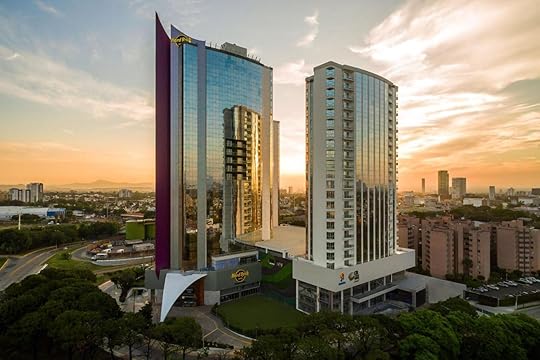
Photo: Booking
Location: Av. Ignacio L Vallarta 5145, Camino Real, 45040 ZapopanHow far from the stadium: 15-minute drivePrice: From $228 per nightIf Grand Fiesta is where the teams might stay, Hard Rock is where the party’s probably happening. Just a 15-minute drive from Estadio Akron, this five-star tower in Zapopan goes big — there’s an infinity pool on the 26th floor, a rooftop lounge with mezcal cocktails and skyline views, and a music theme that runs through the rooms, bars, and even the restaurant menus. The B.I.T.S. Lounge, the hotel’s rooftop bar and dining space, will be popular with guests and locals soaking in panoramic views of Guadalajara over plates of flank steak tacos or octopus tostadas. It’s also around the corner from La Gran Plaza Fashion Mall and less than five minutes from the shops and taco joints on Avenida Patria. It’s highly likely the Hard Rock will throw World Cup events, and you might even luck out with a shuttle.
BookTraveling to the World Cup? Check out Matador’s World Cup accommodations guides: The Best Hotels Near Toronto’s BMO Field for Soccer Fans The Best Hotels Near Monterrey’s Estadio BBVA for Soccer Fans The Best Hotels Near Atlanta’s Mercedes-Benz Stadium for Soccer Fans The Best Hotels Near LA’s Rose Bowl Stadium and SoFi Stadium for Soccer Fans The Best Hotels Near Miami’s Hard Rock Stadium for Soccer Fans The Best Hotels Near New Jersey’s MetLife Stadium for Soccer Fans The Best Hotels Near Philadelphia’s Lincoln Financial Field for Soccer Fans The Best Hotels Near Boston’s Gillette Stadium for Soccer Fans The Best Hotels Near Seattle’s Lumen Field for Soccer Fans The Best Hotels for Visitors Attending the Dallas 2026 World Cup Games The Best Hotels Near Houston’s NRG Stadium for Soccer Fans The Best Hotels Near Arrowhead Stadium in Kansas City for Soccer Fans The Best Hotels Near the Bay Area’s Levi’s Stadium for Soccer Fans The Best Hotels Near Estadio Azteca in Mexico City for Soccer Fans The Best Soccer-Themed Airbnbs for a World Cup Watch Party HG Hotel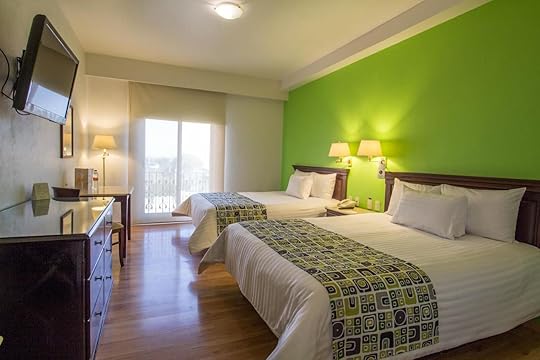
Photo: Booking
Location: Av. Ignacio L Vallarta 5281, Real Vallarta, 45020 ZapopaHow far from the stadium: 13-minute drivePrice: From $77 per nightIf you need a clean, affordable place to crash after a fixture, HG Hotel, a three-star property in Zapopan, is one of the better-reviewed budget picks near Estadio Akron, with surprisingly spacious rooms and rates starting under $80 per night. It’s about a 13-minute drive from the stadium, and while this isn’t the spot for rooftop cocktails, you will find comfortable beds, a good breakfast buffet, and a small gym. Junior suites come with Jacuzzis and overlook Avenida Vallarta, while standard rooms face the inner courtyard. There’s not much nightlife on site, but Plaza Galerias is just a few minutes away if you need dinner.
BookHoliday Inn Express Guadalajara Vallarta Poniente by IHG
Photo: Booking
Location: Carretera Guadalajara-Nogales, No. 440, San Juan de Ocotán, GuadalajaraHow far from the stadium: 35-minute walk or a 5-minute drivePrice: From $68 per nightAnother budget-friendly option for World Cup travelers is the Holiday Inn Express Guadalajara Vallarta Poniente. It’s just a five-minute drive or a manageable 35-minute walk to Estadio Akron — not bad, especially for the price. Rooms are simple but comfortable, and the rates include a decent breakfast spread with chilaquiles, beans, and a rotating daily dish. There’s a compact gym, a small pool, and even a complimentary local shuttle that covers the stadium zone — though it would be wise to check if they’re running on game days. The hotel sits off a major road with easy Uber access to nearby malls and quick eats, and its straightforward setup is ideal if you’re planning to spend more time in the stands than at the hotel.
BookHyatt Regency Andares Guadalajara
Photo: Booking
Location: Blvd. Puerta de Hierro 5065, 45116 ZapopanHow far from the stadium: 20-minute drivePrice: From $308 per nightThis is my luxe hotel of choice. The Hyatt Regency Andares sits in the heart of Zapopan’s swankiest district, connected directly to the Andares Mall with its upscale boutiques, cocktail bars, and some of the city’s best restaurants. It’s a 20-minute drive to Estadio Akron, but you’ll hardly be thinking about that when you’re floating in the light-drenched tranquil pool, sipping tequila on the terrace at Andares Lounge, or tucking into fresh crepes at Cassola’s breakfast buffet. The rooms are sleek and elegant, with skyline views and blackout curtains. If you upgrade to Regency Club access, you’re looking at daily cocktail hours and one of the best complimentary breakfasts in town. Between the Kinal Spa, the 24-hour gym, and the city’s best boutiques downstairs, this is hands down one of the better high-end stays in Guadalajara.
BookSheraton Guadalajara Expo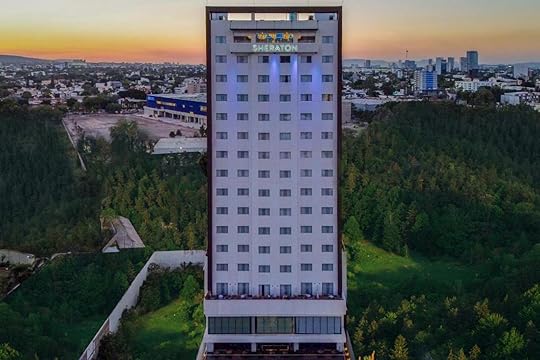
Photo: Booking
Location: Av. Mariano Otero 1510, Rinconada del Sol, 45055 GuadalajaraHow far from the stadium: 25-minute drivePrice: From $117 per nightSet near Plaza del Sol and about a 25-minute drive from Estadio Akron, Sheraton Guadalajara Expo is a good option if you’re hoping to cash in (or rack up) some Bonvoy points during your World Cup trip. Rooms are modern and comfortable, with floor-to-ceiling windows and all the essentials. There’s a mellow rooftop pool, a spa, and La Prieta — the hotel’s all-day restaurant — serves a globally inspired menu with Mexican flourishes. But the real draw here might be the ground-floor sports bar, where you’ll find fellow soccer fans, big screens, and decent cocktails.
BookThe Westin Guadalajara
Photo: Booking
Location: Av de Las Rosas 2911, Verde Valle, 44530 GuadalajaraHow far from the stadium: 20-minute drivePrice: From $191 per nightThe Westin Guadalajara, across from Expo Guadalajara in the upscale Verde Valle district, is another strong contender for where players and staff might stay during fixtures. It’s about a 20-minute drive to Estadio Akron and close to Plaza del Sol and the World Trade Center, with plenty of dining and shopping in the area. Rooms are modern and comfortable, with blackout curtains, Westin’s signature beds, and large windows overlooking the city. There are some excellent options for on-site dining, too. Grill & Vine serves breakfast and dinner with a mix of local and international dishes, while Suvicheria offers sushi and cold beers in a relaxed, unfussy setting, and El Candil, the sleek ground-floor bar, is where to go to wind down with a good tequila. One to bookmark: the overall setup hits that sweet spot between value for money and exceptional hospitality. 
Where to Eat, Play, and Stay During the 2026 Seattle World Cup Matches

Dubbed the “Emerald City” thanks to its forested terrain, Seattle is famous for its nature, among many other things: Starbucks, Nirvana, Grey’s Anatomy, and its rainy weather.
But one element that isn’t necessarily well-known to non-locals is its role in the global soccer scene. In fact, Seattle has been called the “capital of world soccer” (though it’s a title many cities may challenge). Given the city’s long-standing soccer history and present-day soccer fervor, it’s only fitting that Seattle will host six matches in the 2026 FIFA World Cup.
Soccer’s presence in the Emerald City can be traced back to the 1880s when Irish immigrants who worked in coal mines formed a league that eventually became the Greater Seattle Soccer League (in the 1920s). The legacy stuck, and eventually, the first iteration of the Seattle Sounders was formed in 1974 as part of the North American Soccer League (NASL), followed by a second iteration that played in the A-League from 1994 to 2008. Today’s version of the Seattle Sounders – one of the leading teams in Major League Soccer – was formed in 2009.
A few years later, the Seattle Reign followed as one of eight inaugural teams in the National Women’s Soccer League (NWSL), and recently retired Seattle Reign FC midfielder and Seattle resident Megan Rapinoe is a prominent name in both soccer and the LGBTQIA+ community. Beyond the pro teams, Seattle’s soccer culture trickles down into its pre-professional leagues, Ballard FC and Salmon Bay FC.
In June and July 2026, Seattle will host six FIFA World Cup games at Lumen Field in Seattle’s SoDo District, where the Seahawks, Sounders, and Reign play throughout the year. Fortunately, the stadium is in the heart of the city and walking distance from many of Seattle’s famous attractions, making it an excellent location for travelers who want to catch a World Cup match and explore one of the best cities in the PNW.
Here’s what you need to plan your trip to the Seattle World Cup matches, whether you’re a first-time visitor or return traveler.
We hope you love the spaces and experiences we recommend! Just so you know, Matador may collect a small commission from the links on this page if you decide to book a stay or tour. Listed prices are accurate as of the time of publication.
Sporty things to do between Seattle World Cup matchesIn addition to soccer, Seattle, sandwiched between the Puget Sound and the Cascade Mountains, is a hub for sports and outdoor adventure. Go beyond tourist hot spots like the Space Needle and Pike Place by celebrating the city’s active spirit during your visit.
Catch a sports game
Photo: Alika Jenner/Getty Image
If you’re lucky, you may be able to snag tickets for one of the six World Cup matches in Seattle. If not, you can still honor the city’s soccer spirit by visiting Starfire Sports in Tukwila (about 12 miles south of downtown Seattle). Covering over 50 acres, the soccer-dedicated facility includes two indoor fields, restaurants, and athletic training. It’s used for Sounders and Seawolves training and is also home to youth summer camps.
Starfire hosts games throughout the year, and you might be able to catch a (non-pro) soccer game. You can also support other professional Seattle teams. Not far from Lumen Field, the Seattle Mariners will be playing MLB games all summer at T-Mobile Park. If you’re interested in a behind-the-scenes peek, you can also book a tour of T-Mobile Park and see highlights including the Mariners Hall of Fame and interview room.
Experience Sounders culture in Pioneer Square
Photo: Nick 1L/Shutterstock
An important stop on any soccer-inspired trip to Seattle is Pioneer Square. This historic neighborhood is distinguished by its leafy streets lined with late 19th-century Romanesque Revival-style buildings filled with art galleries and coffee shops. It’s also likely to be lively during the Seattle World Cup games, as it’s fan central during Sounders games.
It’s an MLS tradition called “March to the Match,” beginning in Pioneer Square. About an hour before each Sounders game, fans meet at Occidental Park (decked out in green and blue gear and Sounders FC scarves, of course) and march the three blocks to Lumen Field, singing and chanting along the way.
Check out The Ninety while you’re in the neighborhood, which doubles as the front office for the Sounders FC and a central gathering place for soccer fans and events. At The Ninety, you can also find displays of Sounders trophies and Posters by the People. Plenty of events are anticipated to take place in Pioneer Square during the Seattle World Cup matches.
Celebrate with other soccer fans
Each host city will have at least one official FIFA Fan Festival. Photo: Luis Ayerves Photography/Shutterstock
Seattle is famed for its waterfront views, surrounded by Lake Washington, Lake Union, and the Puget Sound. During the World Cup in summer 2026, visitors can get a taste of this classic Seattle scenery at the official FIFA Fan Festival, hosted at the Pier 62 Waterfront Park. The historic pier in downtown Seattle is set against the backdrop of mountains and the Puget Sound. Throughout the World Cup, Fan Fest will host daily events to celebrate soccer’s past and present in the Emerald City, and show all matches throughout June and July on a big screen. It’s likely there will be other public events around the Seattle World Cup games in additional locations throughout the city; more information will be on the .
Spend a day on the water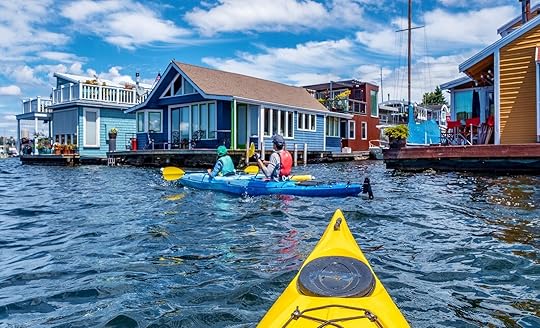
Photo: oksana.perkins/Shutterstock
Paddle, kayak, sail, take a dip, or simply lounge on the shores of Lake Washington, Lake Union, or the Puget Sound. Seattle culture is inseparable from the water and a trip there is incomplete without dipping your toes in at least. A day at Lake Washington even comes recommended by Megan Rapinoe.
Kayak and paddle board rentals are available at shops around the city. On Lake Washington, you can rent from spots like Agua Verde Paddle Club and the Waterfront Activities Center near the University of Washington, or rent Alki Kayak Tours on the Puget Sound, which also has rentals and guided tours around the Sound in West Seattle.
Go sailing
Photo: Airbnb
You can sail around Seattle, just like how Team USA will hopefully sail into victory in the city. Experience Seattle’s sailing culture by joining lifelong sailor Captain Grant for a day on the Puget Sound. The Airbnb Experiences tour sets sail from Shilshole Marina in Ballard, and visitors will learn some sailing basics while looking for marine life, and catching sunset over Mount Olympus. The tour starts at $115 per person and is offered every day of the week during the summer.
Where to eat and drink during the Seattle World CupSeattle has a fun food scene influenced by its maritime culture and is also renowned for its buzzing coffee shops and craft breweries. Here’s where to get a taste of Seattle beyond its diverse range of soccer bars.
Santo Coffee Co.View this post on InstagramA post shared by Santo Coffee Co. (@santocoffeeco)
Experience Seattle’s coffee culture beyond Starbucks (locals will rarely be spotted there, anyway) and instead, try out some of the city’s independent coffee joints. The best place to start for soccer fanatics is Santo Coffee. In the Roosevelt neighborhood in north Seattle, Santo was dreamed up by former Sounders FC player Fredy Montero and his wife in collaboration with another husband-wife duo. The stylish space brews Colombian coffee – a nod to Montero’s home country.
Santo Coffee Co.: 1325 NE 65th St, Seattle, WA 98115
Hatback Bar and GrilleView this post on InstagramA post shared by Hatback Bar & Grille at The Boxyard (@hatbacksea)
Just across the street from Lumen Field, Hatback Bar and Grille is a staple in the Seattle sports scene. Hatback was created around the celebration of sports history in the Pacific Northwest, from baseball to soccer. The spacious bar is convenient for pre- or post-game libations or bites and with 20 TVs, the bar has optimal viewing for Seattle World Cup match days even if you don’t have tickets for the game. Microbrews, fresh seafood, and pub classics pay tribute to the region’s culinary scene.
Hatback Bar and Grille: 1201 1st Ave S, Seattle, WA 98134
Pitch the BabyView this post on InstagramA post shared by Pitch The Baby (@pitchthebabybar)
Opening in the summer of 2025, Pitch the Baby will be the go-to spot for all fans of female sports. Tucked among the tree-lined streets of North Capitol Hill, this newcomer is a new sports bar for women, by women. Pitch the Baby, launched by three female culinary powerhouses in Seattle, will be a place to celebrate local teams like the Seattle Reign and Seattle Storm, all while eating elevated, Mexican-inspired bites.
Pitch the Baby: 600 19th Ave E, Seattle, WA 98112
Eat at a Sounders-endorsed restaurantView this post on InstagramA post shared by Phnom Penh Noodle House (@phnompenhnoodlehouse)
A few years back, the Sounders FC recommended several BIPOC and minority-owned restaurants in Seattle. Support the local community and explore Seattle’s diverse ethnic make-up by filling up at some of these locally owned, Sounders-endorsed spots. Great options include family-run Phnom Penh Noodle House, opened by Cambodian refugees in the 1980s and specializing in Cambodian noodles, and Young Tea (a women-owned shop specializing in Taiwanese milk tea) are perfect for game-day fare. Both spots are in Seattle Chinatown-International District, a neighborhood steeped in history and a short walk from the Seattle World Cup matches at Lumen Field.
Vino FCView this post on InstagramA post shared by Kelyn Rowe (@vinofc_)
It doesn’t have a storefront, but look out for events and wine tastings hosted by Vino FC. Started as a passion project by Washington native and former Sounders player Kelyn Rowe, Vino FC is a monthly wine club featuring hand-selected wines by Rowe. For out-of-towners, Vino FC occasionally hosts tastings in-person. So keep an eye out for events happening around the World Cup, and you may have the chance to sample wines with Rowe.
Where to Stay for the Seattle World Cup matches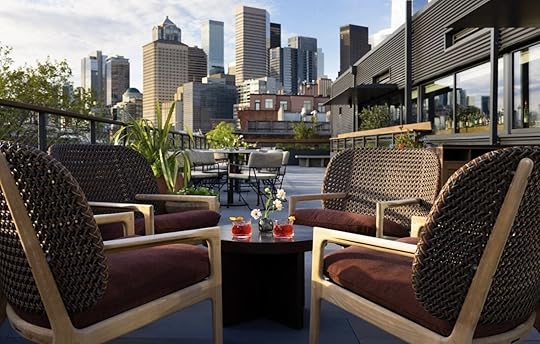
Photo: Booking.com/Populus Seattle
Lumen Field is as convenient as can be to downtown Seattle, so you don’t need to travel to the suburbs to catch the matches. That means you can decide where to stay based on what neighborhood you want to explore or what hotel you’re keen to try, rather than trying to find a hotel next to a public transportation system or close to the freeway.
Read more about the best hotels near Seattle’s Lumen Field.
Populus HotelPopulus Hotel opened its doors during the late spring of 2025 and brought a new shade of “green” to the Emerald City, adopting biophilic practices that made it Seattle’s first carbon-positive hotel. In Pioneer Square, Populus is a five-minute walk to Lumen Field, making it as convenient as it is environmentally friendly. Rooms start around $380 per night in the summer, plus taxes and fees.
Book NowCitizenM Pioneer SquareModern, efficient, and no-fuss, citizenM’s Pioneer Square location is complete with clean, high-tech rooms that don’t break the bank. CitizenM is an easy 12-minute walk to the stadium and has a stylish bar and coffee shop downstairs to fuel up pre- and post-game. Rooms start around $170 plus taxes and fees in the summer.
Book NowSpacious home with media roomThis modern, three-bedroom, three-bath house in the south Seattle neighborhood of Georgetown is an ideal home base if you’re traveling with a group of friends or a family to the Seattle World Cup games. Georgetown is about a 10-minute drive from both downtown and Pioneer Square and has plenty of local restaurants and breweries. The media room’s 130-inch projection screen and popcorn maker, as well as the outdoor grill and fireplaces, would be a great spot to barbeque and watch the matches from home. 
Inside Air France’s $18,000 Suites With Five Windows and a Full Bed

For decades, while economy air passengers are continuously getting nickel-and-dimed, those who can afford to fly in more luxurious classes have been able to choose from a variety of improving products. Airlines like Turkish Airways are bringing award-winning chefs into the airline meal culinary process, and Singapore Airlines introduced what amounts to private studio apartments in the sky.
In the last month, United Airlines unveiled next-generation suites that brought the airline’s offerings to a whole new level. The new “Polaris Studios” are even more luxurious than standard Polaris seats, and come with on-the-ground perks like private check-ins and VIP transportation between terminals.
But now, new suites from Air France outdo even Polaris Studio — and they’ll soon be available to travelers from the US.
Air France launches posh new suitesOne window not enough for you? How about five?

Photo: Air France
Air France just launched the very first flights with its new “La Première” suites. They’re an offering that has been around since 2014, but the new version just became available on select flights between Paris and major metropolitan cities, including New York, Los Angeles, San Francisco, and Washington, DC, among others. However, the new La Première seats will be expanded to nearly all international flights by the end of 2026. It’s a luxury offering, emphasizing privacy, modularity, and a hassle-free VIP experience from airport arrival to landing.
 Photo: Air France
Photo: Air France Photo: Air France
Photo: Air France Suites have pull-out storage for bags and shoes, rather than overhead bins. Photo: Air France
Suites have pull-out storage for bags and shoes, rather than overhead bins. Photo: Air France The two ensuite screens are controlled by a personal tablet at each seat. Photo: Air France
The two ensuite screens are controlled by a personal tablet at each seat. Photo: Air France Photo: Air France
Photo: Air FranceEach aircraft has just four of the new suites, each with nearly 40 square feet of space. Suites have floor-to-ceiling curtains to make them more private, as well as a separate seat and chaise lounge. Together, they fold out into a full-size lay-flat bed. Each suite also has two large TV screens, high-end headphones and bluetooth connectivity, and a personal pull-out storage area with space for clothing and shoes. Passengers’ clothing and bags can be in the cabinet for most of the flight, as they’re given pajamas from French designer Jacquemus (beloved by The White Lotus costume designers) and slippers, plus high-end amenity kits. After meal time, flight attendants will transform the seating areas into beds with mattress toppers and high-end duvet blankets.
 The La Premiere amenity kit. Photo: Air France
The La Premiere amenity kit. Photo: Air France Dining in the Air France Lounge in Paris' airport. Photo: Air France/
Dining in the Air France Lounge in Paris' airport. Photo: Air France/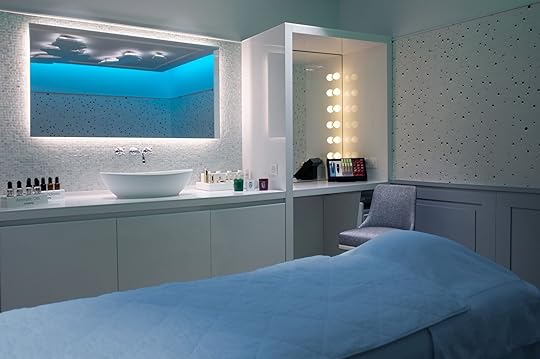 A spa room in the Air France Lounge in Paris, just for La Premiere flyers. Photo: Air France
A spa room in the Air France Lounge in Paris, just for La Premiere flyers. Photo: Air France The wellness suite in the Air France Lounge in Paris, just for La Premiere flyers. Photo: Air France
The wellness suite in the Air France Lounge in Paris, just for La Premiere flyers. Photo: Air France La Premiere passengers get VIP perks, like transportation between gates in Paris. Photo: Air France
La Premiere passengers get VIP perks, like transportation between gates in Paris. Photo: Air FranceAt Charles de Gaulle airport in Paris, La Première guests have a private check-in lobby and an exclusive lounge complete with a beauty and wellness bar. Each guest will have a personal La Première booking agent available to assist with travel logistics before and after the flight who can book services like massages in the exclusive area of the Air France Lounge in the airport. On board meals and cocktails are curated by Michelin-starred chefs like Emmanuel Renaut (who actually has three stars), and the wine menu is curated by a Master Sommelier (of which there are only 269 in the world). Guests will also receive a travel amenity kit from French brand Sisley, which recently won the “best in-flight amenity kit” at the 2024 TravelPlus Airlines Amenity Awards.
The new offering is different from the previous versions of La Première in several ways. The center suites can be combined for couples or separated with a full-height electric partition, and overhead bins were removed to make the suites more spacious. The beds are also the longest in the sky at 6.5 feet (roughly the size of a standard king-sized bed), and guests have a full five windows per suite — each with touch dimming controls, naturally.
The starting price for a midweek round-trip ticket in Air France’s new La Première suite from New York City to Paris is approximately $18,000 for La Prmeière Basic, as of May 2025, or $25,000 for La Première Flex Extra, which includes refundability and a credit back to the airline to buy sustainable fuel. 
May 28, 2025
The Best Hotels Near Mexico City’s Estadio Azteca for Soccer Fans

Let’s get one thing out of the way: yes, FIFA signage might call it Estadio Banorte or Estadio CDMX, but ask literally anyone in Mexico City where soccer is played, and they’ll refer to the historic stadium as Estadio Azteca. The name’s iconic, and no amount of sponsorship rebranding is going to change that — especially not when it’s hosting the opening match of the 2026 World Cup.
Azteca sits down in the southern part of the city in an area called Santa Úrsula Coapa — roughly 30 to 45 minutes from the Centro Histórico depending on traffic (and how ambitious your Uber driver is feeling). It’s not exactly the city’s most scenic or walkable neighborhood, but it is where up to 87,000 fans will be piling in to kick off the tournament. So, logistics matter.
If you’re hoping to roll out of bed and stroll to the gates, your options are slim. But plenty of well-located hotels are just a short drive (or even walk) away — and if you stay in Coyoacán, you get the best of both worlds: easy access to the stadium and a leafy neighborhood where cobblestone streets wind past markets, food stalls, and colorful colonial architecture.
There are other exciting neighborhoods to base yourself — Condesa, Roma, Juárez, and San Miguel Chapultepec — which might offer a more interesting stay, especially if this is your first time to CDMX. If that’s more your speed, check out Matador’s guide to Condesa Airbnbs or these rental picks in the city’s trendiest neighborhoods. Just keep in mind that getting across the city on a matchday will not be straightforward.
Whether you’re in town for the opener or one of the knockout rounds, these are the best hotels near Estadio Azteca, from boutique stays with personality to budget-friendly picks — all close enough to the stadium to avoid a major headache.
We hope you love the hotels near Estadio Azteca we recommend! Just so you know, Matador may collect a small commission from the links on this page if you decide to book a stay. Listed prices are accurate as of the time of publication.
The best hotels near hotels near Estadio AztecaAgata Hotel Boutique & Spa
Photo: Booking
Location: Avenida México 21, Coyoacan, 04100 Mexico CityHow far from the stadium: 19-minute drivePrice: From $163 per nightAgata Hotel is the top five-star boutique in Coyoacán — and easily one of the most atmospheric stays in the neighborhood. This would be my pick if you’re coming to Mexico City for more than just a fixture and appreciate standout service and refined amenities. The property is surrounded by museums, markets, and jacaranda-lined plazas, and the rooms are full of thoughtful details like Kindles, vegan minibars, and locally made textiles. If your match schedule is packed, the on-site spa can help you reset with a facial or massage. You can also unwind on the leafy rooftop terrace or book one of the hotel’s private cooking classes. You’re within walking distance of the Frida Kahlo Museum and Centenario Garden, and Agata’s partnership with local guides makes it easy to arrange tours that dig into the food, history, and culture of the neighborhood.
BookCity Express Plus by Marriott Ciudad de México Periférico Sur Tlalpan
Photo: Booking
Location: Boulevard Adolfo Ruiz Cortines No. 4860 Col. Guadalupe Del. Tlalpan, 14388 Mexico CityHow far from the stadium: 35-minute walk or a 15-minute drivePrice: From $84 per nightIf you’re flying into CDMX just for the match and need a room to crash and dash that’s clean, straightforward, and close, City Express Plus by Marriott Periférico Sur Tlalpan gets the job done. For under $100 per night, you get what you pay for. That said, it’s one of the only hotels within walking distance of Estadio Azteca — about 35 minutes on foot. Rooms are basic but functional, with desks and minifridges, and breakfast is included (continental with a few Mexican staples). There’s also a small café on site serving hot meals throughout the day. It’s not far from a handful of malls if you’re squeezing in errands or looking to kill time before heading to the stadium.
BookDoubleTree by Hilton Toluca
Photo: Booking
Location: Calle Industria Minera 503 Colonia San Lorenzo Tepaltitlan, Delegación San Lorenzo TepaltitlánHow far from the stadium: One-hour drivePrice: From $128 per nightDoubleTree by Hilton Toluca isn’t close to Estadio Azteca — it’s at least an hour-and-a-half drive (without traffic) — but it’s one to consider if you’re hoping to stay where the teams might be based. With La Nueva Casa del Fútbol nearby — one of the likely training facilities during the tournament — the hotel could be hosting players. This means rooms might already be booked up, but it’s worth checking. It’s located in Toluca’s industrial area, and since there’s no public transport link to the stadium, you’re looking at a ride share or the hotel shuttle if they’re putting one on. The decor’s a little dated, but previous guests rate it highly for comfort, service, and its on-site dining options — a cantina-style restaurant with regional dishes, a casual spot for pizza and salads, and a grab-and-go counter serving Starbucks. There’s also an indoor pool and gym for anyone planning to stick around between fixtures, though chances are you’d be scouting the lobby for players instead.
BookHacienda Peña Pobre
Photo: Booking
Location: Cam. a Sta. Teresa 480-2, 14266 Mexico CityHow far from the stadium: 10-minute drivePrice: From $278 per nightIf you’re looking for something classic and close to Estadio Azteca, the four-star Hacienda Peña Pobre is worth booking now before it fills up. Just 10 minutes from the stadium and backed by Bosque de Tlalpan — a gorgeous green space popular with runners and locals escaping the city — this 18-room hotel feels like a private residence. The building dates back to the 19th century and still wears its heritage well, though interiors have been updated with contemporary furnishings and original art by local creatives. Rooms range from minimalist suites with kitchens to compact duplexes, and while there’s no on-site restaurant, staff are quick with recommendations, and the surrounding area has more dining options than you’d expect this far south. Overall, it’s a quiet, luxurious retreat where you might forget there’s a tournament on — until it’s time to head to the stadium.
BookHotel Galería Plaza San Jerónimo
Photo: Booking
Location: 300 Avenida Contreras, 10200 Mexico CityHow far from the stadium: 15-minute drivePrice: From $195 per nightHotel Galería Plaza San Jerónimo is one of the more popular stays among visiting fans. It’s a 15-minute drive to Estadio Azteca, set in the residential Jardines del Pedregal district at the edge of the Sierra Madre foothills. Rooms are large and bright, with light wood floors, modern tech like Bluetooth speakers and flat-screens, and minimalist decor offset by bold accent walls. There’s a gym, yoga space, and three on-site restaurants serving everything from salads to chilaquiles, which is helpful in such a suburban area. The Cuernavaca bike path, just a couple blocks away, runs through the neighborhood and into the foothills. While there’s no bike rental shop on-site, several nearby shops offer day rentals if you’re up for exploring.
BookHyatt Regency Mexico City Insurgentes WTC
Photo: Booking
Location: Av. Insurgentes Sur 724 Col Del Valle, 03100 Mexico CityHow far from the stadium: 35-minute drivePrice: From $203 per nightThis is my pick if you’re going with a branded hotel and don’t mind sitting in some traffic to get more comfort and better service. It’s about 35 minutes from Estadio Azteca — not close, but worth it if you’re sitting on Hyatt points or trying to rack them up. Rooms come with Bluetooth speakers, minibars, rainfall showers, and pillowtop beds with down comforters. There’s a rooftop bar, two restaurants, and a 24-hour fitness center. It’s worth checking with the front desk closer to kickoff to see if they’ll be running a stadium shuttle. It’s also steps from the World Trade Center complex and the mural-covered cultural venue, Poliforum Siqueiros — plus some of Mexico City’s better taco counters.
BookPunto Lofts Periférico Sur
Photo: Booking
Location: 5374 Periferico Sur, Coyoacan, 04710 Mexico CityHow far from the stadium: 30-minute walk or a 15-minute drivePrice: From $112 per nightPunto Lofts Periférico Sur is one of the better apartment-style stays near Estadio Azteca if you want your own setup and a place that feels more lived-in than a standard hotel room. The 18 lofts are modern and designed for longer stays, with laundry, high-speed Wi-Fi, and a decent kitchen setup. It’s a 15-minute drive or a half-hour walk to the stadium. There’s a grocery store a few blocks away, plus neighborhood spots for tacos and coffee if you don’t feel like cooking. Nightly rates start around $100, but you can also book by the week or month.
BookRoyal Pedregal
Photo: Booking
Location: Periferico Sur, 4363 Jardines en la Montana, 14210 Mexico CityHow far from the stadium: Eight-minute drivePrice: From $143 per nightIf you’re traveling with kids and need a four-star hotel near Estadio Azteca, Royal Pedregal might make your shortlist — even if it wouldn’t top mine. It’s not going to win any design awards, but kids under 12 stay free, and you’re just eight minutes from the stadium. That alone could spare you the nightmare of trying to cross town with your young children in gridlocked traffic. Situated in the Jardines en la Montaña neighborhood, the hotel is in a quieter residential pocket just off Periférico Sur. You’re a quick rideshare from Perisur — one of the city’s biggest malls — and the Diego Rivera–designed Anahuacalli Museum if you’ve got downtime to fill. There’s a large outdoor pool, a lobby bar with live music some evenings, and two restaurants on-site: Tezka, a fine-dining spot, and Primavera, which offers a long list of Mexican and international plates, from duck tacos to pear strudel. 
The Best Hotels Near the Bay Area’s Levi’s Stadium for Soccer Fans

2026 will be a very big sports year for the San Francisco Bay Area. More specifically, it’ll be a very big year for Levi’s Stadium. As the home of the NFL’s 49ers, the Santa Clara venue will host Super Bowl LX on February 8, 2026 — but that’s not all. In June and July, the stadium will be the site of six FIFA World Cup matches, including one knockout game on July 1 that just about every soccer fan will want to see.
Although tickets for the biggest soccer tournament in the world are not available for purchase just yet, hotel bookings are already open. And while the San Francisco Bay Area abounds in accommodation options, Levi’s Stadium can welcome up to 71,000 supporters at once, filling up all the available Airbnbs, Vrbos, and hotels in the area. In other words: you’d better get on it. Lucky for you, we’ve pre-selected the 11 best hotels near Levi’s Stadium. Take a look and get a move on.
We hope you love the hotels near Levi’s Stadium we recommend! Just so you know, Matador may collect a small commission from the links on this page if you decide to book a stay. Listed prices are accurate as of the time of publication.
The best hotels near hotels near Levi’s StadiumAC Hotel by Marriott San Jose Santa Clara
Photo: Booking
Location: 2970 Lakeside Dr, Santa ClaraHow far from the stadium: 45-minute walk or a five-minute drivePrice: From $149 per nightWhile the AC Hotel by Marriott San Jose Santa Clara might be too far to walk to and from Levi’s Stadium (about 45 minutes on foot versus five minutes by car), it’s so highly rated, so beautifully decorated, and has so many great amenities that it’s probably worth the parking fee.
Although the outside of this property looks like the facade of any modern hotel chain, the inside is elegant and modern in the same way an independent luxury hotel would be. And that’s not just in the lobby; the bars and restaurants, the outdoor pool area, and the rooms feature sleek and sophisticated decor and furnishings, too.
Amenities at this property include an outdoor pool area with fire pits and sun beds, a fitness center, a well-appointed convenience store, laundry facilities, and two food and drink options. The AC Kitchen is the spot for a gourmet breakfast, while the AC Lounge serves tapas and drinks in a casual, yet chic atmosphere. For those who prefer to find their sustenance outside of the hotel, there are also Mexican, Italian, and fast food options in the area (less than a mile away).
The rooms are all furnished with queen- and king-size beds and work desks, and all feature 55-inch flat-screen TVs, fast WiFi, and mini-fridges.
BookThe Ameswell Hotel
Photo: Booking
Location: 800 Moffett Blvd, Mountain ViewHow far from the stadium: 11-minute drivePrice: From $200 per nightWhile it’s only 11 minutes from the stadium by car, the Ameswell Hotel is the only property on this list located more than five miles from the sports venue. But it’s worth the extra time spent on the road.
Selected by the famous Michelin Guide as a high-quality property, this luxury, zero-plastic boutique hotel is for the soccer fan who likes to splurge a little, and those who like to rub shoulders with the wealthy tech people who are here to do business.
Amenities include an outdoor saltwater pool with private cabanas and sun loungers, a fitness center with a virtual private trainer, and a spa where you can treat yourself to massages and facials.
The hotel’s extensive art collection is one of its most alluring features. Take some time to explore the property and admire it. This list can help guide you through the highlights.
There are three dining and drinking options on site: Roger, a bar and restaurant serving Californian food; the Fly-By for breakfast, lunch, and coffee; and the wine bar.
The decor throughout the property is beautiful, with high-quality furnishings, stylish lighting, and all the bells and whistles of a high-tech hotel, including 65-inch TVs and super-fast WiFi. Organic bath products and deluxe bedding complete this perfect picture.
BookAvatar Hotel Santa Clara, Tapestry Collection by Hilton
Photo: Booking
Location: 4200 Great America Pkwy, Santa ClaraHow far from the stadium: 21-minute walkPrice: From $132 per nightOnly 21 minutes on foot from Levi’s Stadium, the highly rated Avatar Hotel Santa Clara, with its bright decor, fun art, and trendy furnishings, is the ideal property for those who want to stay somewhere a little more special than a regular chain hotel.
And although it is very stylish, the colorful interior isn’t this hotel’s only asset. The outdoor pool with its sun loungers and retro umbrellas makes for a great place to relax, while the two fitness rooms, packed with equipment, will help you keep your exercise routine. Parkstone Wood Kitchen + Taps is the only food and drink option on site and serves American-style plates for dinner only.
All the rooms feature work desks, Tempur-Pedic beds (double, queen-, and king-size), coffee makers, mini-fridges, plush linens, and LCD TVs. Accessible rooms are available.
BookEmbassy Suites by Hilton Santa Clara Silicon Valley
Photo: Booking
Location: 2885 Lakeside Dr, Santa ClaraHow far from the stadium: 45-minute walk or a six-minute drivePrice: From $169 per nightWhile the well-rated Embassy Suites by Hilton Santa Clara Silicon Valley is less than two miles away from Levi’s Stadium, it will take you nearly 50 minutes to get there on foot. If you don’t feel like walking, note that it’s only a six-minute car ride.
Amenities at this modern property include a garden, an indoor heated pool, a well-appointed fitness center, a convenience store selling snacks and drinks, and a beautiful lobby with comfortable furniture. On-site dining options include Café Valley Plaza Bar for drinks and bites after 4 PM, and Café Valley Plaza Dinner & Bar for American fare after 5:30 PM. Cooked-to-order breakfast is included with this hotel.
The pet-friendly rooms and suites feature microwaves, mini-fridges, work desks, and double, queen-, and king-size beds. The largest suites can accommodate up to four guests.
BookFairfield Inn & Suites by Marriott San Jose North/Silicon Valley
Photo: Booking
Location: 656 America Center Ct, San JoseHow far from the stadium: 35-minute walk or a five-minute drivePrice: From $154 per nightUnless you’re a trooper, the very well rated Fairfield Inn & Suites by Marriott San Jose North/Silicon Valley might be a little too far from the stadium for you to hoof it, a 35-minute walk. If you’d rather drive, however, it should be a breeze, as it’s only a six-minute ride.
While it’s not next door to Levi’s Stadium, this hotel’s location isn’t all that bad, as it’s on the waterfront. That means you can take a walk or a bike ride right on the bay and even get a room with water views.
Amenities at this property include an outdoor pool with sun loungers and umbrellas, a hot tub, a 24-hour fitness center, a tennis and basketball court, mini golf, laundry facilities, a large outdoor patio with comfortable furniture, and a convenience store for snacks and drinks.
There’s a free daily continental breakfast, and The Salty Pond Bistro & Bar serves dinner and cocktails every day from 5 PM to 10 PM. There is also a variety of food and drink venues in the area, including Mexican and Italian restaurants, steakhouses, and sports pubs.
The King Rooms, King Suites, and Double Queen Rooms all feature work desks and ergonomic chairs so you can do a little remote work before or after the soccer matches.
BookHilton Santa Clara
Photo: Booking
Location: 4949 Great America Pkwy, Santa ClaraHow far from the stadium: Two-minute walkPrice: From $149 per nightUnless you’re planning to camp by Levi’s Stadium’s doors, the Hilton Santa Clara is the closest you can get to the sports venue, just two minutes on foot. All that spare time you’ll have by not having to drive and find a parking spot? Spend it wisely by honing your face-painting skills and ironing your favorite jersey.
This pet-friendly property has laundry facilities, a heated outdoor pool and hot tub, a fitness center decked out in weights and cardio equipment, and three food and drink options. There’s a coffee bar that serves Starbucks drinks, as well as La Fontana, a Mediterranean-California fusion restaurant that welcomes guests for breakfast, lunch, and dinner. The La Fontana Lounge is only open for dinner and is a more intimate space where you can also enjoy cocktails and Californian specialties.
All the rooms and suites at this property offer the same modern and run-of-the-mill decor, with double, queen-, and king-size beds in a variety of configurations. There are many different accessible rooms and suites for those with special needs. In-room amenities include luxury bath products, a 65-inch HDTV, Cuisinart coffee makers, and mini-refrigerators. Rooms with views of the stadium are available, so be sure to request one for an almost immersive experience.
BookHyatt Centric Santa Clara Silicon Valley
Photo: Booking
Location: 3100 Lakeside Dr, Santa ClaraHow far from the stadium: Six-minute drivePrice: From $158 per nightOnly a six-minute drive to Levi’s Stadium, the excellent Hyatt Centric Santa Clara Silicon Valley is a modern, pet-friendly hotel that has everything you’ll need during your stay.
Amenities at this property include a convenience store for snacks and drinks, and a fitness center equipped with Peloton bikes. There’s also a large courtyard with a lagoon-style pool, a hot tub, sun loungers, and day beds, as well as a classy lobby with elegant and comfortable furnishings where guests can work and relax. Loggia is the only restaurant-bar on site and serves breakfast, dinner, and cocktails indoors or on the patio in a casual yet elegant setting.
The Hyatt Centric Santa Clara Silicon Valley comprises 220 modern suites, all with exceptional views of Silicon Valley. All accommodations feature 55-inch TVs, luxury bath products, deluxe hair dryers, blackout curtains, coffee makers, and bathrobes. The rooms are also soundproof, so you’re guaranteed a quiet night. Suites come in a variety of configurations with double, queen-, and king-size beds.
BookHyatt Regency Santa Clara
Photo: Booking
Location: 5101 Great America Pkwy, Santa ClaraHow far from the stadium: Five-minute walkPrice: From $150 per nightThose who don’t want the hassle of having to drive and find suitable parking on game day would do well to book a room at the Hyatt Regency Santa Clara, located just five minutes on foot from Levi’s Stadium.
The highly rated Hyatt property has all the amenities that you’d expect from a modern chain hotel, including a heated outdoor pool surrounded by palm trees, sun loungers, day beds, and plush private cabanas. There’s also a large fitness center with all the necessary equipment to keep you in shape during your stay, and a convenience store (Grab N’ Go Market) where you can purchase snacks, fruit, and hot and cold beverages, including wine.
Of course, there’s more than the Grab N’ Go Market for your on-site dining needs. The casual Evolution Restaurant and Bar is open all day, every day, and serves American-inspired Italian dishes and cocktails. Truya Sushi, open for lunch and dinner, is a sake and sushi lounge that serves innovative Japanese cuisine.
The Hyatt Regency Santa Clara is a large property with 505 rooms and eight suites. While all of the rooms have 312 square feet of space and are decorated the same, they come in a variety of configurations and have everything you need: deluxe bath amenities, 48-inch Samsung HD flat-screen TVs, to name a few. The suites are a different story entirely. Yes, they feature the same immaculate interior and modern furnishings, but they range from 685- to 909-square-foot, and some even have a balcony. Also, in the suites, TVs are a little bigger, there are Peloton bikes, and the coffee makers are fancier. Note that some of the suites and rooms have stadium views, so be sure to request one if you want to keep your eyes on the prize for your entire stay.
BookSanta Clara Marriott
Photo: Booking
Location: 2700 Mission College Blvd, Santa ClaraHow far from the stadium: 25-minute walkPrice: From $168 per nightIf you don’t mind walking one mile (25 minutes) to get to the stadium, the highly rated Santa Clara Marriott might just be the accommodation for you.
The property has a large fitness center, as well as a heated outdoor pool and hot tub equipped with sun loungers and umbrellas, so you can partake in pre- and post-match relaxation. There are also two food and drink options: The Orchard for an American breakfast, and Bosc + Bartlett for casual drinks, lunch, or dinner indoors or on the patio around the fire pit. If you want to explore the area around the hotel for sustenance, there’s a Mexican eatery and a bistro serving steaks and seafood less than a mile away.
The Santa Clara Marriott is a very large hotel with 766 rooms and suites, including 30 rooms with patios that offer direct access to the pool area or the courtyard. Upper-floor rooms feature step-out balconies in case you want to get some fresh air and sunshine. The rooms are all immaculately clean, modern, and decorated in a very similar fashion with work desks, mini-fridges, and plush bedding.
BookTETRA Hotel, Autograph Collection
Photo: Booking
Location: 400 W Java Dr, SunnyvaleHow far from the stadium: 10-minute drivePrice: From $170 per nightThis modern and luxurious property is only a 10-minute drive from Levi’s Stadium and offers gorgeous decor and a host of amenities, including a heated outdoor pool with comfortable sun beds, multiple patios with fire pits, and a gym equipped with Peloton bikes.
There are three excellent food and drink options on site, including Coffee Manufactory, which serves coffee and locally made baked goods; Adrestia, which offers Californian-Asian fusion food; and Nokori, a Japanese whisky bar.
While the decor in the spacious, immaculate rooms and suites is very minimalistic, comfort is the top priority, with luxury linens, robes, marble bathrooms, comfortable seating, tea and coffee makers, designer hair dryers, and deluxe bath products. The property’s common spaces are sophisticated and furnished with taste, privacy, and relaxation in mind. 
Where to Eat, Play, and Stay for the 2026 NJ/NY World Cup Matches

As the 2026 World Cup culminates with its final match at MetLife Stadium in East Rutherford, New Jersey, all eyes will be on the New York metropolitan area. For soccer fans, it’s not just the match that matters; it’s the atmosphere, the culture, the food, and the full-on experience. And there’s no better backdrop for that than New York and New Jersey.
Soccer has deep roots in the region. From the days of Pelé at the New York Cosmos in the 1970s to the current passion for NYCFC and the New York Red Bulls, the beautiful game has long found a home here. New York is a melting pot of cultures, many of which brought their soccer traditions with them, giving the city an unrivaled diversity in both fandom and footwork. It’s also a media and cultural hub, and you can expect an electric World Cup atmosphere in every borough, neighborhood, and bar.
Whether you’re flying in from overseas, road-tripping from another part of the US, or a local looking to soak in the action, here’s your ultimate guide to where to eat, stay, and play in NY and NJ during the 2026 FIFA World Cup finale.
Things to do in NYC and NJ for sports fansWhether you’re in town for the World Cup or just looking to immerse yourself in the city’s rich soccer culture, there are plenty of places to explore. From iconic stadiums to historic soccer sites, NYC and NJ offer a variety of experiences that keep the soccer energy going off the field.Take a soccer tour of the city

Soccer legend Pele playing at Randall’s Island in the 1970s. Photo: NYC Cosmos
New York City and New Jersey boast a deep soccer history that fans should explore. Start at Randall’s Island, where soccer legend Pelé played with the Cosmos in the 1970s. The island still hosts local tournaments and soccer events today. Then head to Flushing Meadows Corona Park in Queens, where the international community regularly gathers for pickup games and soccer culture thrives. Also worth a visit are iconic venues like Citi Field, home of the New York Mets, and Yankee Stadium, where NYCFC splits its time for home matches.
Get in on the hometown MLS spirit
Photo: New York Red Bulls
Even if you’re here for the World Cup, you can’t ignore the MLS vibe. Sports Illustrated Stadium in Harrison, NJ is one of the league’s premier soccer-specific stadiums. Check if the New York Red Bulls or Gotham FC – yes, the region is lucky enough to have two MLS teams and one NWSL team – are hosting any events, open training sessions, or meet-and-greets during the tournament period. The regular seasons will be put on pause for the event, but you may still find players who aren’t in the World Cup at the stadium training before the NY World Cup matches take place.
Sports Illustrated Stadium: 600 Cape May St., Harrison, NJ 07029
Meet NJ’s most influential figures
Photo: New Jersey Hall fo Fame
While you’re in the area, check out the New Jersey Hall of Fame, also in New Jersey, celebrating the state’s most influential athletes, entertainers, and leaders. Visitors are greeted by the “Wall of Fame,” where illuminated LED displays introduce more than 15 years of inductees, from Thomas Edison and Albert Einstein, Whitney Houston, and Bruce Springsteen. It’s extremely interactive and hands-on, allowing guests to sing next to holograms of legends like Gloria Gaynor or Frankie Valli, or conduct “interviews” in a recreated TV studio. Tickets are $25 for non-New Jersey residents and available online.
The New Jersey Hall of Fame: 1 American Dream Way, Court G, Level 3, East Rutherford, NJ 07073
Immerse yourself in fan zones and watch parties
Photo: ms_pics_and_more/Shutterstock
During the NY World Cup matches, fan zones and massive watch parties will pop up across the region, creating a buzzing atmosphere. The official fan zone for the city will be at Liberty State Park in Jersey City, New Jersey, but organizers said they haven’t ruled out hosting events in Central Park, too. And there will likely be watch events around Times Square, for anyone interested in outdoor viewing. The fan zone in Liberty State Park will have a large screen where fans can gather, watch the matches, and join the collective energy of cheering for their teams. Expect lively, international crowds, food vendors, and even cultural performances that add to the experience. The official fan zone in each city is perfect for experiencing the global passion of soccer, no matter which country you’re rooting for.
Liberty State Park: 1 Audrey Zapp Dr, Jersey City, NJ 07305
Go beyond the game with some classic NYC attractions
Photo: Christopher Moswitzer/Shutterstock
Off the pitch, New York and New Jersey have plenty to offer for soccer fans and visitors alike. From skyline views at the Top of the Rock or Edge NYC to world-class art at MoMA or the Met, NYC’s iconic experiences capture the city’s spirit. Take a stroll along the High Line, or hop on the free Staten Island Ferry for stunning views of the Statue of Liberty. Across the Hudson, New Jersey’s American Dream mall just minutes from MetLife Stadium has an indoor ski slope, DreamWorks Water Park, and shopping galore.
Where to eat and drink during the NYC World Cup matchesIn a city where the global game is celebrated on nearly every corner, eating and drinking becomes part of the fan experience. From pubs packed with passionate supporters to restaurants that serve as unofficial home bases for national teams, the New York metro area offers plenty of ways to stay fueled and plugged into the action.
Smithfield Hall NYCView this post on InstagramA post shared by New York City Hammers (@nychammers)
Just a short walk from Penn Station, Smithfield Hall is ground zero for soccer culture in Manhattan. Far from your average sports bar, it’s a full-on football hub. The walls are lined with scarves from clubs around the world, and the multiple screens ensure you never miss a minute, no matter how many matches are on. During the World Cup, expect the bar to be packed with supporters’ groups from various nations, especially those from Europe and South America. Smithfield is also the official NYC bar for Chelsea FC and hosts regular Premier League, La Liga, and Champions League watch parties throughout the year. The bar food menu covers the basics like wings, sliders, burgers, but the real draw is the atmosphere: chanting fans, international accents, and bartenders who can talk tactics between drink orders.
Smithfield Hall: 138 W 25th St, New York, NY 10001
Legends/The Football FactoryView this post on InstagramA post shared by Legends Bar & Grill NYC (@legendsnyc)
Sitting near the Empire State Building, Legends is a classic for international matches. And beneath that is The Football Factory, a shrine to the game and one of the most authentic soccer viewing experiences in the US with a deeply committed crowd. It’s the go-to venue for fan groups from Italy, Portugal, Nigeria, and Japan, among others, and often hosts multiple watch parties at once, each with its own corner of the bar.
During World Cup season, the energy is palpable, and you’ll find crowds singing national anthems and swapping jerseys. If you want to feel like you’re watching the final from a pub in Europe, this is the closest you’ll get in NYC.
Legends/The Football Factory: 6 W 33rd St, New York, NY 10001
Black Horse PubView this post on InstagramA post shared by Black Horse Pub (@blackhorsepub.sportsbar)
Black Horse Pub in Park Slope blends Brooklyn cool with serious soccer passion. It’s a favorite among English expats and hardcore Premier League fans (especially Tottenham Hotspur supporters) and during major tournaments, it transforms into a mini stadium of its own. The bar doesn’t just show games; it lives them. Expect early morning openings, fans in full kits, and volume levels that rival MetLife Stadium. The bar is co-owned by a pair of soccer lovers who’ve made it a mission to create a communal space for the sport. The menu is hearty and British: think fish and chips, shepherd’s pie, and a full English breakfast on weekends.
Black Horse Pub: 568 5th Ave, Brooklyn, NY 11215
Where to stay for the NJ & NY World Cup games
Photo: Booking.com/Arlo NoMad
Finding the right place to stay can keep you close to the excitement and reduce time spent in transit. Whether you’re heading to MetLife Stadium for the final or soaking up the city’s vibrant atmosphere, NYC offers plenty of options for fans looking to be at the heart of the action.
We hope you love the spaces and stays we recommend! Just so you know, Matador may collect a small commission from the links on this page if you decide to book a stay. Listed prices are accurate as of the time of publication.
Ace Hotel New YorkThe Ace Hotel blends vintage style with modern energy in NYC’s NoMad neighborhood. It’s a popular hangout for creatives and travelers alike, with a lively lobby bar that’s hosted World Cup watch parties in the past. Rooms start around $330 per night in the summer.
Book NowHI NYC HostelAffordable, social, and well-located on the Upper West Side, HI NYC Hostel is a great option for fans traveling in groups or solo. The outdoor courtyard, communal kitchen, and organized events make it easy to meet fellow travelers and connect with fans from every corner of the world. It’s a great place to stay if you just need a place to crash and make friends, rather than a private luxury room. Beds start around $70 per night in the summer.
Book NowArlo NoMadThe Arlo in Midtown Manhattan is a sleek, centrally located boutique hotel ideal for fans looking to stay connected to the city’s energy. With compact, modern rooms and floor-to-ceiling views, it’s a stylish base just steps from subway lines, soccer bars, and fan zones. Rooms start around $300 per night in the summer.
Book NowWhether you’re watching, celebrating, or exploring, the World Cup experience in NYC and NJ is one you’ll carry with you long after the final whistle. 
Where To Eat, Play, and Stay in Houston for the 2026 World Cup

Houston will host seven matches of the 2026 FIFA World Cup, including five group-stage games and two knockout-round fixtures, at the 72,000-seat NRG Stadium. The city is ready – it’s hosted a Super Bowl, college playoffs, and has one of America’s most tech-forward airports. Beyond the matches, Houston offers an unforgettable cultural experience with its diverse population, award-winning restaurants—including Michelin-recognized dining—dynamic arts scene, and iconic attractions like NASA’s Space Center.
If you plan to visit for a match or more, stay and play in EaDo (East of Downtown), Midtown, which is south of EaDo and closer to the stadium, or the university-adjacent Upper Kirby area. The two former neighborhoods easily connect to NRG Stadium by train, while the latter is closer for ride shares and offers a more relaxed vibe. All three have sports bars and dining to excess – here’s what to get yourself into white in the city.
What to do in EaDo during the 2026 World CupEaDo is the home of soccer in Houston. Shell Energy Stadium (formerly BBVA Compass Stadium), where the Houston Dynamo (MLS) and Houston Dash (NWSL) play their home games, is located here. Although the World Cup matches take place further south at NRG Stadium, this area area is packed with lively bars, restaurants, and nightlife, many of which cater to sports fans and it will be a hub of action during the tournament.
EaDo is also well-connected via the METRORail Green and Purple lines, providing easy access to other parts of the city and down to NRG Stadium. The neighborhood has undergone significant revitalization, resulting in a mix of new apartments, townhomes, and converted warehouses, attracting a young and energetic crowd
Pitch 25View this post on Instagram
A post shared by sphere (@sphere.club)
This soccer-themed bar offers 100 beers on tap and is directly across from Shell Energy Stadium. Corn hole and other beer games can be played, and there’s plenty of outdoor seating.
Pitch 25: 2120 Walker St
Take a sports tour with Houston Historical Tours
Photo: Sean Pavone/Shutterstock
Houston HIstorical Tours offers a tour that covers the vast history of pro sports in Houston. You’ll visit current and former stadium sites, get the lowdown on iconic players and titles, and depending on the package you choose, gets in inside tours of ballparks and stadiums throughout the city.
Chapman & KirbyView this post on Instagram
A post shared by Chapman & Kirby (@chapmanandkirby)
Elevated eats and cocktails are the specialty at Chapman & Kirby, with a trendy vibe that makes it a great place to start or base a night out in EaDo.
Chapman & Kirby: 2118 Lamar St #100
Where to stay in EaDo during the 2026 World CupWe hope you love the spaces and stays we recommend! Just so you know, Matador may collect a small commission from the links on this page if you decide to book a stay.
Home with rooftop patio, dry bar, and balcony Photo: Airbnb
Photo: Airbnb Photo: Airbnb
Photo: Airbnb Photo: Airbnb
Photo: Airbnb Photo: Airbnb
Photo: AirbnbIf you’re traveling with a crew, this EaDo house is the spot to chill and pregame before heading to matches or out for the night. It sleeps eight, has plenty of room, and is walkable to everything in the neighborhood.
Townhouse with city-view rooftop patio Photo: Airbnb
Photo: Airbnb Photo: Airbnb
Photo: Airbnb Photo: Airbnb
Photo: AirbnbRare is the spot in Houston with a better skyline view than this EaDo townhouse. The space sleeps six and is an ideal crash pad for exploring the city and taking the train down south to NRG Stadium. There’s a hot tub, to boot.
What to do in Midtown during the 2026 World CupMidtown sits between Downtown and the Museum District and is known for its vibrant nightlife, diverse dining options, and walkability. With three METRORail Red Line stations, Midtown offers quick access to NRG Stadium and both Downtown and EaDo, making it convenient for attending matches or joining watch parties. The area is popular with young professionals and has a lively atmosphere on game days.
Social Beer GardenView this post on Instagram
A post shared by Social Beer Garden HTX (@socialbeergardenhtx)
Social Beer Garden is known for hosting watch parties for major tournaments like the World Cup, Champions League, and the Euros. There are 20 indoor TVs, a large outdoor screen, drink specials, and even breakfast for early games.
Social Beer Garden: 3101 San Jacinto St
Solarium Sports LoungeView this post on Instagram
A post shared by Rex Hospitality Group (@rexhospitalitygroup)
Part sports bar, part sports venue – all awesomeness. Solarium Sports Lounge is a great place to pass afternoons before heading to a match or watch party, and is certain to have matches on to watch if you’re having too much fun to leave.
Solarium Sports Lounge: 820 Holman St
Little Woodrow’s MidtownView this post on Instagram
A post shared by Little Woodrow’s Houston (@littlewoodrowshtx)
Little Woodrow’s has locations in most trendy Houston neighborhoods, and its Midtown outpost is particularly great during major sporting events. Expect a lively crowd of locals and travelers, and spend some time on the patio.
Little Woodrow’s Midtown: 2306 Brazos St
Where to stay in Midtown during the 2026 World CupMidtown mod house with garage and walkability Photo: Airbnb
Photo: Airbnb Photo: Airbnb
Photo: Airbnb Photo: Airbnb
Photo: Airbnb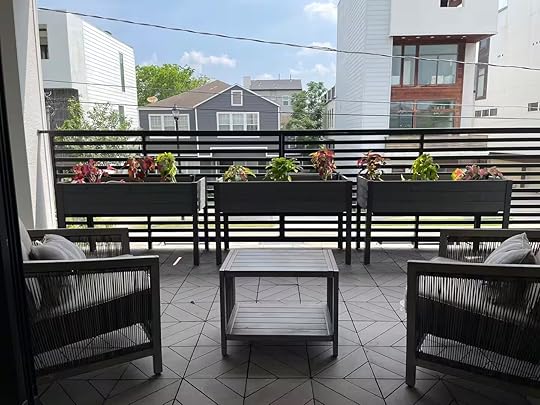 Photo: Airbnb
Photo: AirbnbWith room for eight guests and a great patio in a quiet neighborhood, this home is ideal for a group or family getaway to the World Cup. Parking is available onsite and its a 10-minute walk to the metrorail.
Luxury Midtown condo near transit Photo: Airbnb
Photo: Airbnb Photo: Airbnb
Photo: Airbnb Photo: Airbnb
Photo: AirbnbEasily get around the city from this Midtown pad and then rest in comfort when you return. Room for eight, newly remodeled, and plenty of space to lounge.
What to do in Upper Kirby/Greenwood Plaza for the 2026 World CupUpper Kirby and Greenwood Plaza blend the vibrancy of a university district and urban core but drop the hecticness of neighborhoods closer to downtown. There isn’t a direct train line to NRG Stadium from the area, but bus service is available and this area is a good spot for those planning to take an Uber to the match.
Kirby Ice HouseView this post on Instagram
A post shared by Kirby Ice House (@kirbyicehouse.htx)
Kirby Ice House has a massive backyard, over 60 beers on tap, and plenty of TVs. The food trucks and lively atmosphere make it a go-to for group outings and game days.
Kirby Ice House: 3333 Eastside St
On The KirbView this post on Instagram
A post shared by On The Kirb (@on_the_kirb)
Sports bars and pub grub aren’t often associated with healthy lifestyles and responsible sourcing. On The Kirb bucks this trend with a menu of organic food and craft beverages. Plenty of TVs, as well.
On The Kirb: 5004 Kirby Dr
Where to stay in Upper Kirby/Greenwood Plaza for the 2026 World CupUpper Kirby apartment with pool, gym, and work space Photo: Airbnb
Photo: Airbnb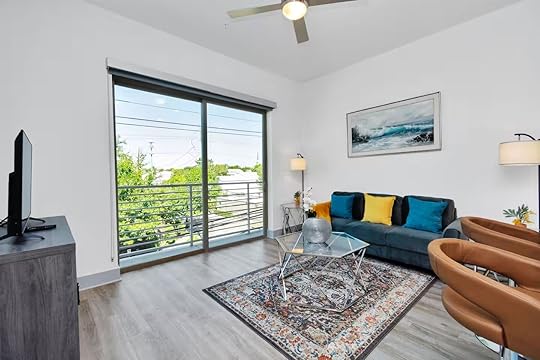 Photo: Airbnb
Photo: Airbnb Photo: Airbnb
Photo: AirbnbIf you need to maintain your schedule in Houston, this is the spot at which to do it. You’ll be in a luxury apartment complex with the standard amenities, and nearby to the above social settings. NRG Stadium isn’t too far, either.
Luxury art deco house in Upper Kirby Photo: Airbnb
Photo: Airbnb Photo: Airbnb
Photo: Airbnb Photo: Airbnb
Photo: AirbnbFeel like you’re in a classic Hollywood film at this spot that’s nearby to the best of the neighborhood and has room for eight guests across four bedrooms. 
Where to Eat, Play, and Stay for the LA FIFA World Cup Matches

The 2026 FIFA World Cup is coming to North America, and one of the host cities is none other than the capital of the entertainment industry, Los Angeles. LA, tied with Chicago for the most stadiums in a US city, has developed an impressive soccer culture. This is due in part to its most famous local team, LA Galaxy (the former home of David Beckham), and to immigrants from the UK, Europe, and Latin America who brought their passion for the world’s favorite sport.
So it’s not surprising that between June 12 and July 10, the city will host eight matches at SoFi Stadium, including the US Men’s National Team kickoff match and one quarter final.
Coming from Greece myself, I grew up with a slight soccer obsession, bolstered by my father and cemented by a Premier League soccer rivalry with my roommate in college. In LA, I found not only my people – but also my sports bars.
I often see that people who visit LA find many of their stereotypes of the city destroyed within a few days of exploring the depth, culture, and hidden nooks of the neighborhoods. From oases of nature to prestigious art museums, local dive bars to upscale restaurants, the best thing about LA is that it’s so varied, you can curate your own personalized version of the city.
If you’re planning to be in the city for the LA World Cup matches, here’s what you need to know to plan the perfect trip.
Sporty things to do between LA World Cup matchesLA has long had a reputation for being outdoorsy, populated by surfers, sun-soakers, and people keen on having perfect weather for playing outside. Fortunately, that’s what you’re likely to have during the LA World Cup matches, as the city’s coastal location means ocean breezes even on hot days. And the San Gabriel mountains just to north can be windy, cooler, and perfect for summer days in LA.
See the sights of Griffith Park
Photo: Maggie Yesko/Shutterstock
Griffith Park is so beautiful that it’s a favorite hangout for both tourists and locals. Head over in the early afternoon to take in the view of downtown and the rest of LA spreading out below the park in all directions, then walk by the soccer fields, where you’ll likely find locals playing the beautiful game.
Toward sunset, hike up Mount Hollywood, where you will be rewarded with one of the most stunning sights in the city: the orange-purple sky of an LA sunset behind the lights of Griffith Park Observatory and the downtown skyline. Finish your visit by a walk through the Observatory itself to explore the planetarium, and if you have the patience to wait in line, take a peek through the Zeiss telescope to look at the night sky. It’s free to visit the observatory, but the planetarium show is $10.
Griffith Park Observatory: 2800 East Observatory Road, Los Angeles, CA 90027
Stroll the sands at Venice Beach
Photo: Chizhevskaya Ekaterina/Shutterstock
See one of the most iconic beaches in the world up close by walking or biking – or even rollerblading – along the boardwalk. You’ll pass people working out at Muscle Beach and have the chance to marvel at the supremely talented kids nailing flips and tricks at the beach’s famous skatepark. Finish your visit by dipping your feet into the chilly but gorgeous Pacific Ocean.
If the World Cup has you feeling energized and active, rent a bike and ride it all the way up to Santa Monica, then finish up your day by watching the sunset at the Santa Monica Pier.
Venice Beach: 1800 Ocean Front Walk, Venice, CA 90291
Tour the historic Rose Bowl
Photo: Grindstone Media Group/Shutterstock
Head up to Pasadena to tour the site of the 1994 Men’s World Cup Final and 1999 Women’s World Cup Final. Built in 1922 and opened in 1923, the Rose Bowl may be one of the most famous sports venues in the world, though it’s age is why it wasn’t chosen for the 2026 FIFA World Cup.
Go on a tour to see the original 1922 locker room, learn about the Rose Bowl’s historic importance and its role in major sporting events, including five Super Bowls and two World Cups.
Rose Bowl: 1001 Rose Bowl Dr, Pasadena, CA 91103
Explore the California Science Center
Photo: Karolis Kavolelis/Shutterstock
The California Science Center is less a museum, and more an immersive dive into scientific education with jaw-dropping interactive exhibit and an IMAX theater with a 7-story screen showing vivid documentaries on the universe, science, and nature.
From May 15, 2025 through at least the 2028 Olympics, the California Science Center will also host the 17,000-square-foot GAME ON! Science, Sports & Play exhibit, a perfect stop for families. Visitors will learn how scientific sports principles can improve both their lives and their game. But the exhibit is also very hands-on, allowing guests to try baseball swings, swim in a virtual pool, and of course, work on technology-enhanced drills to perfect their soccer kick. It’s free to visit the Science Center, though the IMAX shows and other activities have fees.
California Science Center: 700 Exposition Park Drive, Los Angeles, CA 90037
Where to eat and drink in LALA may be known for flashy restaurants, taco stands, and celebrity-loved, Michelin starred kitchens, but don’t be mistaken: it knows a thing or two about fantastic sports bars, too. For a longer list of watering holes you won’t want to miss, check out Matador Network’s guide to the best soccer bars in LA.
No. 10 Restaurant
View this post on InstagramA post shared by Italian Restaurant Los Angeles (@n10losangeles)
Owned by former Juventus FC player, World Cup winner, and all around soccer legend Alessandro Del Piero, No. 10 pays homage to both the star’s jersey and his Italian roots. The restaurant, on foodie favorite 3rd Street, leans on authentic, multi-regional Italian cuisine with seasonal ingredients.
Sit in the open, airy interior space, or opt for the breeze outdoor patio. Regulars recommend any dish featuring the restaurant’s fresh, homemade pasta.
No. 10 Restaurant: 8436 W. 3rd St, Los Angeles, CA 90048
The Fox and HoundsView this post on InstagramA post shared by The Fox & Hounds (@thefoxandhounds)
Deep in Studio City, you will find the closest thing you can get to a British pub in the LA area. The Fox and Hounds has been attracting soccer fans (and local immigrant Brits) for years, thanks to the combination of hearty pub food, stellar beers on draft, and, of course, the TVs showing major international matches.
Check out the soccer schedule on the restaurant’s website ahead of time; though the screens are usually taken up by Premier League games, in the summer of 2026, you can bet the World Cup will be the only thing on the screen.
The Fox and Hounds: 11100 Ventura Blvd., Studio City, CA 91604
N17 The LaneView this post on InstagramA post shared by N17 The Lane | Elevated Sports Bar (@n17thelane)
For something more upscale than a pub but more casual than a Beverly Hills restaurant, try N17 The Lane gastropub in Mar Vista. Not only is the restaurant closer to SoFi Stadium than any other on the list, but it’s owned by a husband and wife team who are die-hard sport fans, and want to attract people just like them to their establishment.
The very name of the restaurant is a tribute to Tottenham Hotspur, and the regulars’ obsession with soccer is evident in the TV screens showing international games whenever possible. Enjoy what one critic called the best burger in LA while watching the World Cup matches happening on the big screen.
N17 The Lane: 12821 Washington Blvd., #103, Culver City, CA 90066
Barney’s BeaneryView this post on InstagramA post shared by Juicy Lucy (@juicy_lucyburger)
Barney’s Beanery is one of the oldest eateries in the city. It opened in West Hollywood in 1920 and has been an LA institution ever since. The bar, known for massive portions, great beer, sports on the TV screens, and games in the back (including pool and Skee-ball) has always had a steady stream of customers, but enjoyed a new popularity boom recently among Gen-Z.
Barney’s Beanery: 8447 Santa Monica Blvd., West Hollywood, CA 90069
Where to Stay for the LA World Cup matches
Photo: Booking.com/The Georgian Hotel
The neighborhood directly around SoFi Stadium isn’t the best place to be based in LA, so you’re better off staying a little further away near some of the city’s iconic tourist destinations.
We hope you love the spaces and stays we recommend! Just so you know, Matador may collect a small commission from the links on this page if you decide to book a stay. Listed prices are accurate as of the time of publication.
Los Angeles Athletic ClubIn the center of downtown LA is the fitness-focused, four-star Los Angeles Athletic Club, housed in a historic building where Olympic athletes stayed and trained. The hotel is a short walk away from most downtown sights, including the Crypto.com arena and the Walt Disney Concert Hall. Rooms start around $200 per night in the summer.
Book NowThe Georgian HotelStay in one of the city’s most beautiful Art Deco buildings facing Santa Monica Beach and the Pacific Ocean. If you’re in town for the sea as much as for the games, this is the hotel for you. Just a few minutes walk away you can enjoy biking, water sports, skating, and other beachy California activities. Rooms at the Georgian start around $450 per night in the summer.
Book NowSoho WarehouseAt Soho Warehouse, you can mix with celebrity guests and athletes flying into town from all over the world to see the World Cup. Enjoy the rooftop pool looking over LA’s trendy Arts District before heading off to a game. Rooms start around $330 per night in the summer, plus taxes and fees.
Book NowOf course, there’s a lot to see in Los Angeles – but you’ll want to plan your LA World Cup lodging and tickets early, so don’t spend too much time planning before committing to a hotel or Airbnb. 
En Nevada, la “Carretera Más Solitaria” Está Llena de Sorpresas

La Carretera 50 de Nevada fue nombrada como “La Carretera Más Solitaria de Estados Unidos” por la revista Life en la década de los ochenta. Si bien esta carretera se caracteriza por sus muchos kilómetros y pocos poblados, “solitaria” no es el mejor adjetivo para describirla. Este camino atraviesa el estado de este a oeste y ha sido un foco de actividad desde que los pasajeros del Pony Express lo utilizaban regularmente; tiempo después, se transformó en parte de la Lincoln Highway, la primera carretera transcontinental pavimentada en los Estados Unidos.
Hoy en día, la Carretera 50 está repleta de atractivos que van de destilerías y restaurantes altamente reconocidos hasta sitios históricos y lugares de belleza natural única. Mientras conduces por aquí, experimentarás asombro, sorpresa y fascinación. ¿Soledad? No tanto. De hecho, todo lo contrario: una vez que comiences a explorar el centro de Nevada, encontrarás muchas cosas por hacer y personas increíblemente amables en cada parada. Prepárate para ir de Fallon a Eureka en un viaje por carretera divertido, auténtico y lleno de aventura.
Primera parada: Fallon
Foto: Omar David
Reno se queda en el espejo retrovisor mientras inicias tu viaje por la Carretera 50. Frente a ti se encuentra Fallon, una zona de gran importancia agrícola. Carga gasolina en The Slanted Porch y asegúrate de llegar a la hora del almuerzo. Peggy y Steve Hernandez son los dueños de este restaurante donde se sirven más de veinte tipos de ensaladas y sándwiches preparados con ingredientes locales. Prueba el Stillwater, un sándwich de ensalada de pollo con ajo y limón, o el Christo, con pechuga de pavo, jamón Selva Negra y queso suizo derretido sobre pan rebozado, espolvoreado con azúcar y servido con mermelada de fresa. Ambos vienen acompañados de sus famosas papas fritas hechas en casa. Las mejores del mundo, según dicen algunos de sus comensales.
A continuación, dirígete a Frey Ranch Farmers + Distillers, especialmente si puedes asistir a uno de sus recorridos y degustaciones los sábados por la tarde. Aquí, el bourbon y el whisky de centeno son elaborados por agricultores de Nevada de quinta generación utilizando sus propios granos. Frey Ranch es un lugar poco común en el mundo de las bebidas espirituosas. Sus procesos, que van de la producción de los granos al embotellamiento, han sido galardonados en diversas ocasiones.
Ahora dirígete al Refugio Nacional de Vida Silvestre Stillwater, designado como un lugar de importancia nacional por la Red Hemisférica de Reservas Para Aves Playeras debido a la gran cantidad de aves que se detienen aquí durante sus rutas migratorias anuales. El refugio cuenta con 32,200 hectáreas donde encontrarás ecosistemas tan distintos como dunas de arena, playas alcalinas y marismas de agua dulce y salobre. Un verdadero oasis en el alto desierto. No olvides tus binoculares.
Si quieres ver artefactos prehistóricos y petroglifos creados hace siglos por los pueblos indígenas de Nevada, no olvides explorar el Sitio Arqueológico Hidden Cave and Grimes Point. Después de una pequeña caminata por un sendero bien señalizado, encontrarás vestigios de otra época, incluyendo los restos de una estructura utilizada para cazar ciervos y antílopes, artefactos nativo-americanos y petroglifos asociados con la caza. Si quieres observar de cerca 21 mil años de historia a través de las capas de roca en Hidden Cave, únete a un recorrido con el Museo del Condado de Churchill (te aseguramos que vale la pena).
A continuación: Middlegate
Foto: Matador Network
Lo extraño y fuera de lo común será una constante mientras recorres las zonas rurales de Nevada. En ocasiones no podrás evitar decir, “¡Pero qué raro!”, y una de esas ocasiones será cuando pases por el Árbol de Zapatos de Middlegate.
Cuenta la leyenda que, hace algunas décadas, una pareja de recién casados viajaba por la Carretera 50 después de contraer nupcias en Reno, cuando tuvieron su primera discusión. Al llegar a una arboleda en Middlegate, la novia dijo que se iría caminando de regreso a casa. Su esposo le respondió que, si quería hacerlo, tendría que ir descalza, y arrojó sus zapatos a un árbol cercano. Eventualmente se reconciliaron y, año tras año, regresaron al mismo árbol en su aniversario para colgar un nuevo par de zapatos como símbolo de su amor eterno.
El árbol original fue talado en 2010 pero los lugareños rápidamente dieron continuidad al ritual en un árbol cercano. Hoy en día, el Árbol de Zapatos de Middlegate se encuentra entre las muchas curiosidades de #WeirdNevada a lo largo de este camino no tan solitario.
Un recorrido por este pueblo no está completo sin una visita a la histórica Estación de Middlegate. Establecida en 1860 como una parada del Pony Express donde los jinetes cambiaban de caballo. Esta estación es hoy en día la única bomba de gasolina en 80 kilómetros a la redonda. Aquí también encontrarás uno de los icónicos Sagebrush Saloons, o Salones de Artemisa, de Nevada; puntos de hidratación donde te sentirás como en el Viejo Oeste. Asegúrate de llegar con hambre, pues las hamburguesas de la estación han sido reconocidas como unas de las mejores en todo Estados Unidos por USA Today.
Espera tu hamburguesa mientras examinas todos los artefactos del Pony Express que se encuentran a tu alrededor. La Monster Burger es el sueño de cualquier carnívoro, compuesta por casi medio kilo de carne Angus. Es difícil terminarla en una sentada, pero si lo logras recibirás una playera y tal vez una ronda de aplausos en reconocimiento a tu compromiso. Claro está que también deberás terminar una enorme montaña de papas para recibir el premio.
Siguiente parada: Austin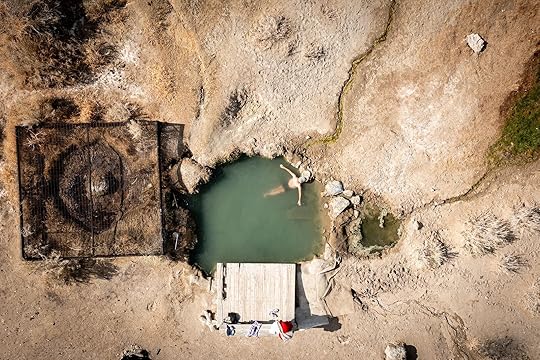
Foto: Brian Lewis
A menos de una hora al este de la estación Middlegate se encuentra la ciudad de Austin, donde puedes aprender sobre historia local, encontrar joyas hechas con piedras de Nevada y relajarte en unas sublimes aguas termales.
Austin fue una próspera ciudad minera durante la Fiebre de la Plata y marca el punto medio de la Carretera 50. Uno de los atractivos de la localidad es el Castillo de Stokes, una rareza arquitectónica construida en 1896 por el magnate ferroviario, promotor minero y banquero Anson Phelps Stokes como casa de verano para su familia. El castillo está hecho de granito de Nevada tallado a mano y su diseño emulaba una torre romana que Stokes alguna vez vio en Italia. La familia Stokes vivió en el castillo apenas un mes, pero la estructura es hoy un recordatorio del patrimonio minero de la región.
Continúa tu recorrido por el pasado de Nevada en el Museo de la Sociedad Histórica de Austin, repleto con la memoria histórica del que alguna vez fuera un centro poblacional activo y bullicioso. Sillas de montar antiguas, equipos de minería, una imprenta original y muchos otros artefactos te transportarán al Viejo Oeste, mientras que los artefactos anteriores a los pueblos shoshone, como piedras de molienda, te remontarán a siglos aún más lejanos.
No olvides dar un paseo por el histórico Palacio de Justicia del Condado de Lander, ahora un centro de visitantes, seguido por las tres iglesias de Austin, construidas entre 1866 y 1878: San Agustín, la Iglesia Metodista y San Jorge. Cerca de allí puedes comprar varios recuerdos de Nevada en Jason’s Art Gallery, donde se elabora joyería fina con piedras de origen local desde hace dos décadas.
Llegó la hora de relajarse después de tanto caminar por Austin. Las aguas termales de Nevada son mundialmente aclamadas y en Spencer Hot Springs entenderás por qué. Piérdete en la observación del vasto paisaje (y en un sinfín de estrellas si vas de noche) mientras te relajas en manantiales geotérmicos que se mantienen a una temperatura de 55 grados. Algunas “bañeras de vaquero”, también conocidas como abrevaderos para ganado, están listas para utilizarse y cuentan con una fuente de agua fresca que te puede ayudar a controlar la temperatura de las tinas. Si quieres pasar la noche aquí puedes hacerlo armando tu propio campamento cerca de los manantiales. Recuerda contribuir a que esta experiencia sea maravillosa para los demás repasando los protocolos de etiqueta antes de tu llegada.
Última parada: Eureka
Foto: Omar David
Una hora al este de Austin encontrarás la “Ciudad Más Amigable en la Carretera Más Solitaria de Estados Unidos”. Un seudónimo bastante largo, pero que bien podría estar en lo correcto. Eureka se estableció en 1864 cuando un grupo de exploradores se aventuró a excavar en esta zona con el fin evitar las multitudes de otros pueblos mineros cercanos. Al poco tiempo dieron con el segundo yacimiento de plata más grande de Nevada, similar únicamente a Comstock Lode, lo que dio como resultado el auge de una nueva ciudad.
Eureka está en el Registro Nacional de Lugares Históricos. Al llegar te sentirás como si hubieras entrado en un museo viviente al que podrás sacarle mucho provecho con un recorrido a pie por 62 lugares históricos, la mayoría dentro de un radio de tres cuadras. Visita la Eureka Opera House, un local con capacidad para 300 personas que data de 1880 y se encuentra perfectamente restaurado. Al otro lado de la calle, echa un vistazo al Eureka Sentinel Museum, la antigua sede del periódico de la ciudad donde aún permanece la imprenta original y otros objetos que te remontarán a los días en que este sitio era una bulliciosa sala de redacción en pleno siglo XIX.
Prepárate para cenar y tomar una copa en el Owl Club Bar and Steakhouse, un lugar reconocido por la calidad de su carne y propiedad de la familia Carrion desde 1981. Una vez satisfecho, dirígete al Jackson House Hotel, un lugar histórico donde podrás pasar la noche en una de las ocho habitaciones de la opulenta (y supuestamente embrujada) propiedad victoriana que ha sido cuidadosamente restaurada para reflejar el apogeo de la ciudad en la década de 1880. Reserva la Suite Jackson (la de mayor actividad paranormal) y la soledad no será un problema que te aflija.
No importa cuántas ni qué paradas hagas, conducir de Fallon a Eureka deja una cosa muy clara: la desinhibida, a menudo deshabitada, Carretera 50 está lejos de ser solitaria. Sal a explorar todo lo que hace de Nevada central un lugar único. 
Matador Network's Blog
- Matador Network's profile
- 6 followers



